Self Respect, Stability, and Green Building
An interview with former Habitat Kent Executive Director, John Kuiper
Pictured above: John on a build site when Habitat Kent was previously Habitat for Humanity of Grand Rapids; Habitat homeowners and John at a groundbreaking ceremony; John volunteering at the all-electric homes on Diamond in 2022, sporting a Habitat Kent Blitz Build shirt from 1997!
John Kuiper served as the second Executive Director of Habitat Kent from 1987 to 1999. He recently sat down with us and talked about the organization’s early days, the start of our quest for energy efficiency, and the impact housing can have on a family’s well-being.
Mark Ogland-Hand, Sr. Donor Relations Specialist, Habitat Kent: Habitat Kent began building LEED-certified homes several years after your time here, but in looking at the old pictures it is apparent that we were always concerned with building energy-efficient homes.
John: Yes, as early as 1987 we were building 2 x 6 exterior walls with continuous Dow board insulation. When I came back to Habitat Kent temporarily [as interim Executive Director in 2010], I was looking back at those old houses and thinking we should be doing a massive energy retrofit, and I found out that the only thing necessary was a little bit of air sealing and attic insulation upgrades, and maybe foundation insulation.
Mark: Because of those past efforts, our houses are great candidates for electrification. Your work back then is really standing the test of time in preparing them for the future.
John: I would tell people that depending on where Habitat families were moving from their utility bills could go from $200 a month to $30 a month.
Mark: That’s still happening. For one of our “Carbon Footprint Builds” the family came from an old drafty home and their utility bills will reflect a huge reduction. But what was it that made you think, “We’ve got to build better, more energy-efficient houses.”
John: I think that was part of the 1980’s construction move toward energy efficiency. There had been recent swings in gas prices that had priced people out of their houses. $400 gas bills. That was in place before I started and I think Dave Jacobs, [one of Habitat Kent’s original board members], was responsible for that. So that was always there.
Mark: Habitat Kent grew a lot during your time as Executive Director, what was it about Habitat that resonated with the community?
John: What was unique about Habitat was that we’re not just a housing ministry; it’s an opportunity to bring volunteers and people in need together, working side by side, learning from each other. It was a ministry to volunteers as well as homeowners. Homeowners, who, through the experience of building their house, developed a sense of self-respect and their families thrived. It wasn’t just rent verses house payments; it was about stability.
We did a project with Calvin College where students interviewed existing homeowners and we heard stories about how their kids were doing better in school. Their quality of life improved not just because of where they were, but because of what they did.
One of my favorite stories involved a family where the mother showed me the kitchen floor of their current housing – it was carpeting that had been pulled up and all that was left was a pad. It couldn’t be cleaned. A year or so later, the mother is in her new Habitat house and is asked, “What do you like best about your Habitat house?”
I thought, “She’s going to talk about that carpet pad in her kitchen.” But she said, “What I like best about my house is that I feel better about myself. I picked out these colors for the walls and they look so good, and I think I’m going to become an interior decorator.”
At that point, it occurred to me that it’s not just about having a decent floor and a low-energy bill. It is about self-respect



